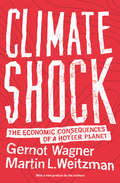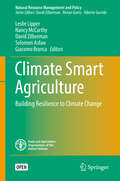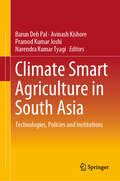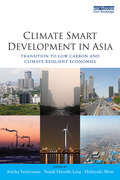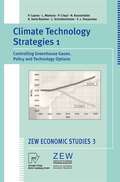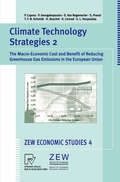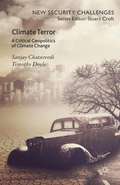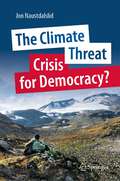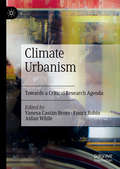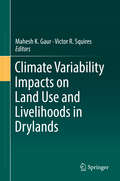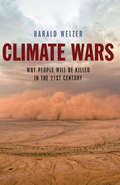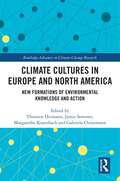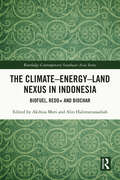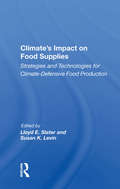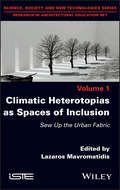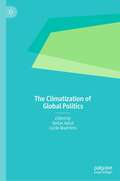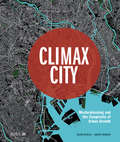- Table View
- List View
Climate Shock: The Economic Consequences of a Hotter Planet
by Gernot Wagner Martin L. WeitzmanIf you had a 10 percent chance of having a fatal car accident, you'd take necessary precautions. If your finances had a 10 percent chance of suffering a severe loss, you'd reevaluate your assets. So if we know the world is warming and there's a 10 percent chance this might eventually lead to a catastrophe beyond anything we could imagine, why aren't we doing more about climate change right now? We insure our lives against an uncertain future--why not our planet?In Climate Shock, Gernot Wagner and Martin Weitzman explore in lively, clear terms the likely repercussions of a hotter planet, drawing on and expanding from work previously unavailable to general audiences. They show that the longer we wait to act, the more likely an extreme event will happen. A city might go underwater. A rogue nation might shoot particles into the Earth's atmosphere, geoengineering cooler temperatures. Zeroing in on the unknown extreme risks that may yet dwarf all else, the authors look at how economic forces that make sensible climate policies difficult to enact, make radical would-be fixes like geoengineering all the more probable. What we know about climate change is alarming enough. What we don't know about the extreme risks could be far more dangerous. Wagner and Weitzman help readers understand that we need to think about climate change in the same way that we think about insurance--as a risk management problem, only here on a global scale.With a new preface addressing recent developments Wagner and Weitzman demonstrate that climate change can and should be dealt with--and what could happen if we don't do so--tackling the defining environmental and public policy issue of our time.
Climate Shock: The Economic Consequences of a Hotter Planet (PDF)
by Gernot Wagner Martin L. WeitzmanIf you had a 10 percent chance of having a fatal car accident, you'd take necessary precautions. If your finances had a 10 percent chance of suffering a severe loss, you'd reevaluate your assets. So if we know the world is warming and there's a 10 percent chance this might eventually lead to a catastrophe beyond anything we could imagine, why aren't we doing more about climate change right now? We insure our lives against an uncertain future--why not our planet?In Climate Shock, Gernot Wagner and Martin Weitzman explore in lively, clear terms the likely repercussions of a hotter planet, drawing on and expanding from work previously unavailable to general audiences. They show that the longer we wait to act, the more likely an extreme event will happen. A city might go underwater. A rogue nation might shoot particles into the Earth's atmosphere, geoengineering cooler temperatures. Zeroing in on the unknown extreme risks that may yet dwarf all else, the authors look at how economic forces that make sensible climate policies difficult to enact, make radical would-be fixes like geoengineering all the more probable. What we know about climate change is alarming enough. What we don't know about the extreme risks could be far more dangerous. Wagner and Weitzman help readers understand that we need to think about climate change in the same way that we think about insurance--as a risk management problem, only here on a global scale.With a new preface addressing recent developments Wagner and Weitzman demonstrate that climate change can and should be dealt with--and what could happen if we don't do so--tackling the defining environmental and public policy issue of our time.
Climate Smart Agriculture: Building Resilience to Climate Change (Natural Resource Management and Policy #52)
by Leslie Lipper Nancy McCarthy David Zilberman Solomon Asfaw Giacomo BrancaThis book is open access under a CC BY-NC-SA 3.0 IGO license.The book uses an economic lens to identify the main features of climate-smart agriculture (CSA), its likely impact, and the challenges associated with its implementation. Drawing upon theory and concepts from agricultural development, institutional, and resource economics, this book expands and formalizes the conceptual foundations of CSA. Focusing on the adaptation/resilience dimension of CSA, the text embraces a mixture of conceptual analyses, including theory, empirical and policy analysis, and case studies, to look at adaptation and resilience through three possible avenues: ex-ante reduction of vulnerability, increasing adaptive capacity, and ex-post risk coping. The book is divided into three sections. The first section provides conceptual framing, giving an overview of the CSA concept and grounding it in core economic principles. The second section is devoted to a set of case studies illustrating the economic basis of CSA in terms of reducing vulnerability, increasing adaptive capacity and ex-post risk coping. The final section addresses policy issues related to climate change. Providing information on this new and important field in an approachable way, this book helps make sense of CSA and fills intellectual and policy gaps by defining the concept and placing it within an economic decision-making framework. This book will be of interest to agricultural, environmental, and natural resource economists, development economists, and scholars of development studies, climate change, and agriculture. It will also appeal to policy-makers, development practitioners, and members of governmental and non-governmental organizations interested in agriculture, food security and climate change.
Climate Smart Agriculture in South Asia: Technologies, Policies and Institutions
by Barun Deb Pal Avinash Kishore Pramod Kumar Joshi Narendra Kumar TyagiThis book discusses various climate smart agro-technologies, their technical and economic feasibility across heterogeneous agro-climatic conditions, assessing farmers’ willingness to adopt those technologies, impact of climate smart technology in agricultural production and possible policy and investment opportunities to upscale it. Containing eight chapters, the book starts with a discussion about the methodological aspects of priority setting of the farm technologies across various regions of South Asia including Eastern Indo-Gangetic plain, Western Indo-Gangetic Plain and arid regions. Using data from field based trials and expert solicitations, the book next deliberates on a list of feasible technologies, assessed by constructing climate smart Feasibility Index. Further on, there is an analysis, using stated preference method, of the behaviour of farmers in adopting climate smart technologies. Preference of women farmers has been given a special focus in this book. After discussing the method priority setting of the farm technologies, impact of climate smart technologies has been analysed using real time data. Government policies have been reviewed with the view of achieving climate smart agriculture in South Asia. The book also describes the optimization modelling framework for investment allocation and technology prioritization. The model integrates both the bio-physical and the economic optimization model to capture the agro-climatic heterogeneity within the region and the variability of technical feasibility across regions and crops. Results of this model will help policy makers to identify how much to invest, where to invest and what technologies to prioritize for investments.
Climate Smart Development in Asia: Transition to Low Carbon and Climate Resilient Economies
by Ancha Srinivasan Frank Hiroshi Ling Hideyuki MoriThe future of China, India and Asia’s other emerging economies and their ability to take a ‘low-carbon’ and ‘climate-resilient’ development path determine the future of global carbon emissions and climate change. Indeed, the battle to confront global climate change will be won or lost in Asia. The transition to a low-carbon, climate-resilient economy (LCE), which involves many steps towards improved energy efficiency, alternative energy sources and transport systems, sustainable land use, eco-friendly consumption and proactive adaptation, may be regarded as the world's fourth revolution, after the industrial revolution, agricultural revolution, and the information revolution. Asia is highly vulnerable to impacts of climate change. Yet because of its dynamic economies and massive populations, Asia offers the greatest opportunity for overcoming the trade-offs and pursuing low-carbon development pathways. With a growing consensus that there is limited time to avoid the worst impacts of climate change, scientists, engineers, policymakers, and economists across Asia have recently begun discussions on how Asia can make a transition to LCE. Most discussions, however, focused on transfer of technologies from developed to developing countries and overlooked other equally important challenges such as financing, governance, and information dissemination. This book is the first to look at these neglected aspects of LCE and attempt to integrate both market-based and technology-based solutions into a comprehensive strategy to creating a roadmap for LCE in Asia. This book is an essential reading for economists, policy makers, practitioners, engineers and researchers concerned with climate change, energy production and development in Asia and the impacts and potential for the world.
Climate Smart Development in Asia: Transition to Low Carbon and Climate Resilient Economies
by Ancha Srinivasan Frank Hiroshi Ling Hideyuki MoriThe future of China, India and Asia’s other emerging economies and their ability to take a ‘low-carbon’ and ‘climate-resilient’ development path determine the future of global carbon emissions and climate change. Indeed, the battle to confront global climate change will be won or lost in Asia. The transition to a low-carbon, climate-resilient economy (LCE), which involves many steps towards improved energy efficiency, alternative energy sources and transport systems, sustainable land use, eco-friendly consumption and proactive adaptation, may be regarded as the world's fourth revolution, after the industrial revolution, agricultural revolution, and the information revolution. Asia is highly vulnerable to impacts of climate change. Yet because of its dynamic economies and massive populations, Asia offers the greatest opportunity for overcoming the trade-offs and pursuing low-carbon development pathways. With a growing consensus that there is limited time to avoid the worst impacts of climate change, scientists, engineers, policymakers, and economists across Asia have recently begun discussions on how Asia can make a transition to LCE. Most discussions, however, focused on transfer of technologies from developed to developing countries and overlooked other equally important challenges such as financing, governance, and information dissemination. This book is the first to look at these neglected aspects of LCE and attempt to integrate both market-based and technology-based solutions into a comprehensive strategy to creating a roadmap for LCE in Asia. This book is an essential reading for economists, policy makers, practitioners, engineers and researchers concerned with climate change, energy production and development in Asia and the impacts and potential for the world.
Climate Technology Strategies 1: Controlling Greenhouse Gases. Policy and Technology Options (ZEW Economic Studies #3)
by Pantelis Capros Leonidas Mantzos Patrick Criqui Nikolaos Kouvaritakis Antonio Soria Ramirez Leo Schrattenholzer E.Lakis VouyoukasClimate Technology Strategies 2: The Macro-Economic Cost and Benefit of Reducing Greenhouse Gas Emissions in the European Union (ZEW Economic Studies #4)
by Pantelis Capros Panagiotis Georgakopoulos Denise van Regemorter Stef Proost Tobias F.N. Schmidt Henrike Koschel Klaus Conrad E.Lakis VouyoukasClimate technology becomes more and more relevant in international environmental policy negotiations. At the Kyoto conference binding emission reduction targets have been established for several regions of the world. The major challenge is how to realize these reduction goals with minimum costs without generating new distributional and social difficulties. The book analyses the macroeconomic structural and distributional impacts of greenhouse gas mitigation strategies for the EU and the member states.
Climate Terror: A Critical Geopolitics of Climate Change (New Security Challenges)
by Timothy Doyle Sanjay ChaturvediClimate Terror engages with a highly differentiated geographical politics of global warming. It explores how fear-inducing climate change discourses could result in new forms of dependencies, domination and militarised 'climate security'.
The Climate Threat. Crisis for Democracy?
by Jon NaustdalslidA key point in the book is the need to focus more seriously at the energy problem as the real problem behind global warming. The failure of global climate policies to reduce CO2 emissions and halt climate change has led an increasing number of scientist and activists to lose confidence in democracy's ability to handle climate change and led them to look to more authoritarian measures to meet the problem. The book documents these trends, also from a historical perspective, criticize them and sketches more democratic alternatives.
Climate Urbanism: Towards a Critical Research Agenda
by Vanesa Castán Broto Enora Robin Aidan WhileThis book argues that the relationship between cities and climate change is entering a new and more urgent phase. Thirteen contributions from a range of leading scholars explore the need to rethink and reorient urban life in response to climatic change. Split into four parts it begins by asking ‘What is climate urbanism?’ and exploring key features from different locations and epistemological traditions. The second section examines the transformative potential of climate urbanism to challenge social and environmental injustices within and between cities. In the third part authors interrogate current knowledge paradigms underpinning climate and urban science and how they shape contemporary urban trajectories. The final section focuses on the future, envisaging climate urbanism as a new communal project, and focuses on the role of citizens and non-state actors in driving transformative action. Consolidating debates on climate urbanism, the book highlights the opportunities and tensions of urban environmental policy, providing a framework for researchers and practitioners to respond to the urban challenges of a radically climate-changed world.
Climate Variability Impacts on Land Use and Livelihoods in Drylands
by Mahesh K. Gaur Victor R. SquiresThis edited volume is devoted to the examination of the implications of the inevitable changes wrought by global change on the welfare and livelihoods of tens of millions of people who live in dryland regions. Global change is more than just climate change and the ramifications of changing trade patterns (geopolitical and economic aspects), the shift to the market economy, demographic factors (population growth, urbanization and re-settlement), receive attention here. Land use change specialists, policy makers and natural resource management agencies will find the book very useful.Chapters focus on examples that are drawn from a number of sources including previously unpublished studies on the impact of climate change, markets and economics on pastoralist and dryland farming households. The key focus is to provide readers with insights into the real world implications of change (including an analysis of the drivers of change) on these vulnerable groups within dryland societies. The role of humans as agents of these changes is canvassed. A regional analysis of the world's drylands is also performed including those in Australia, Argentina, India, North America, China, North Africa, Central Asia and Southern Africa.
Climate Wars: What People Will Be Killed For in the 21st Century
by Harald WelzerStruggles over drinking water, new outbreaks of mass violence, ethnic cleansing, civil wars in the earth's poorest countries, endless flows of refugees: these are the new conflicts and forces shaping the world of the 21st century. They no longer hinge on ideological rivalries between great powers but rather on issues of class, religion and resources. The genocides of the last century have taught us how quickly social problems can spill over into radical and deadly solutions. Rich countries are already developing strategies to garner resources and keep 'climate refugees' at bay. In this major book Harald Welzer shows how climate change and violence go hand in hand. Climate change has far-reaching consequences for the living conditions of peoples around the world: inhabitable spaces shrink, scarce resources become scarcer, injustices grow deeper, not only between North and South but also between generations, storing up material for new social tensions and giving rise to violent conflicts, civil wars and massive refugee flows. Climate change poses major new challenges in terms of security, responsibility and justice, but as Welzer makes disturbingly clear, very little is being done to confront them. The paperback edition includes a new Preface that brings the book up to date and addresses the most recent developments and trends.
Climate Wars: What People Will Be Killed For in the 21st Century
by Harald WelzerStruggles over drinking water, new outbreaks of mass violence, ethnic cleansing, civil wars in the earth's poorest countries, endless flows of refugees: these are the new conflicts and forces shaping the world of the 21st century. They no longer hinge on ideological rivalries between great powers but rather on issues of class, religion and resources. The genocides of the last century have taught us how quickly social problems can spill over into radical and deadly solutions. Rich countries are already developing strategies to garner resources and keep 'climate refugees' at bay. In this major book Harald Welzer shows how climate change and violence go hand in hand. Climate change has far-reaching consequences for the living conditions of peoples around the world: inhabitable spaces shrink, scarce resources become scarcer, injustices grow deeper, not only between North and South but also between generations, storing up material for new social tensions and giving rise to violent conflicts, civil wars and massive refugee flows. Climate change poses major new challenges in terms of security, responsibility and justice, but as Welzer makes disturbingly clear, very little is being done to confront them. The paperback edition includes a new Preface that brings the book up to date and addresses the most recent developments and trends.
Climate Cultures in Europe and North America: New Formations of Environmental Knowledge and Action (Routledge Advances in Climate Change Research)
by Thorsten HeimannBringing together scholarly research by climate experts working in different locations and social science disciplines, this book offers insights into how climate change is socially and culturally constructed. Whereas existing studies of climate cultural differences are predominantly rooted in a static understanding of culture, cultural globalization theory suggests that new formations emerge dynamically at different social and spatial scales. This volume gathers analyses of climate cultural formations within various spaces and regions in the United States and the European Union. It focuses particularly on the emergence of new social movements and coalitions devoted to fighting climate change on both sides of the Atlantic. Overall, Climate Cultures in Europe and North America provides empirical and theoretical findings that contribute to current debates on globalization, conflict and governance, as well as cultural and social change. This book will be of great interest to students and scholars of climate change, environmental policy and politics, environmental sociology, and cultural studies.
Climate Cultures in Europe and North America: New Formations of Environmental Knowledge and Action (Routledge Advances in Climate Change Research)
by Thorsten Heimann Jamie Sommer Margarethe Kusenbach Gabriela ChristmannBringing together scholarly research by climate experts working in different locations and social science disciplines, this book offers insights into how climate change is socially and culturally constructed. Whereas existing studies of climate cultural differences are predominantly rooted in a static understanding of culture, cultural globalization theory suggests that new formations emerge dynamically at different social and spatial scales. This volume gathers analyses of climate cultural formations within various spaces and regions in the United States and the European Union. It focuses particularly on the emergence of new social movements and coalitions devoted to fighting climate change on both sides of the Atlantic. Overall, Climate Cultures in Europe and North America provides empirical and theoretical findings that contribute to current debates on globalization, conflict and governance, as well as cultural and social change. This book will be of great interest to students and scholars of climate change, environmental policy and politics, environmental sociology, and cultural studies.
The Climate–Energy–Land Nexus in Indonesia: Biofuel, REDD+ and biochar (Routledge Contemporary Southeast Asia Series)
by Akihisa Mori Alin HalimatussadiahThis book extends the framework of the climate-energy-land nexus to elucidate political, economic, social, and institutional factors and causal mechanisms that stringent climate targets bring about, rather than mitigate a disproportional heavy burden on the forest sector in Indonesia. Assessing climate, energy, agricultural, forest, and transmigration policies, and REDD+ and biochar solutions through a multidisciplinary approach, ranging from biological, agricultural, technological, economic, and institutional lenses, the book identifies the political-economic and socio-technical regimes that cause the crosssectoral transfer of responsibility for greenhouse gas emissions to palm-oil-based biofuel, imposing an excess burden on the forest sector and accelerating indirect land-use change. It also proposes possible countermeasures for agricultural and forest sectors, reconfirming that technical applications and integrated policymaking should trigger the socioeconomic changes that will make transformative change happen in Indonesia. As an analysis of the success, or otherwise, of stringent climate targets, policies, and technological and non-technological measures on the reduction of greenhouse gases, this book will be of great interest to students and scholars in the fields of environment & sustainability, Asian studies, energy, environment and agriculture, forestry, and agriculture & environmental sciences. It will also appeal to practitioners and policymakers tackling net-zero emissions and land and forest governance.
The Climate–Energy–Land Nexus in Indonesia: Biofuel, REDD+ and biochar (Routledge Contemporary Southeast Asia Series)
This book extends the framework of the climate-energy-land nexus to elucidate political, economic, social, and institutional factors and causal mechanisms that stringent climate targets bring about, rather than mitigate a disproportional heavy burden on the forest sector in Indonesia. Assessing climate, energy, agricultural, forest, and transmigration policies, and REDD+ and biochar solutions through a multidisciplinary approach, ranging from biological, agricultural, technological, economic, and institutional lenses, the book identifies the political-economic and socio-technical regimes that cause the crosssectoral transfer of responsibility for greenhouse gas emissions to palm-oil-based biofuel, imposing an excess burden on the forest sector and accelerating indirect land-use change. It also proposes possible countermeasures for agricultural and forest sectors, reconfirming that technical applications and integrated policymaking should trigger the socioeconomic changes that will make transformative change happen in Indonesia. As an analysis of the success, or otherwise, of stringent climate targets, policies, and technological and non-technological measures on the reduction of greenhouse gases, this book will be of great interest to students and scholars in the fields of environment & sustainability, Asian studies, energy, environment and agriculture, forestry, and agriculture & environmental sciences. It will also appeal to practitioners and policymakers tackling net-zero emissions and land and forest governance.
Climate's Impact On Food Supplies: Strategies And Technologies For Climate- Defensive Food Production
by Lloyd E. SlaterGlobal concern about the impact of climatic variability on food supplies has been growing since 1963 when a major crop failure in the Soviet Union ended a long period of abundant, low-cost surplus grain. Since then a number of sizable crop shortfalls and food supply emergencies throughout the world have encouraged the study of climate-food interact
Climate's Impact On Food Supplies: Strategies And Technologies For Climate- Defensive Food Production
by Lloyd E. SlaterGlobal concern about the impact of climatic variability on food supplies has been growing since 1963 when a major crop failure in the Soviet Union ended a long period of abundant, low-cost surplus grain. Since then a number of sizable crop shortfalls and food supply emergencies throughout the world have encouraged the study of climate-food interact
Climatic Heterotopias as Spaces of Inclusion: Sew Up the Urban Fabric
by Elias MavromatidisThis book explores, discusses and considers spatial research and its relevant pedagogic perspectives on the crossings, interactions and transformations of contemporary territorialities. The book addresses the issue of conceiving "translocal" spaces of inclusion within the framework of contemporary imposed nomadism and climate change. The concept of "climatic heterotopias" is an original, elegant concept, introduced into the pedagogy of architecture to develop teaching which aims to bring together the architectural substance and this real social need that aims to mitigate the spatial effects of climate change. Climatic Heterotopias as Spaces of Inclusion promotes the use of spatial theory and philosophy as the tools to build a strong architectural concept. The purpose of the individual contributions in the book is to introspectively explain the original concept of "climatic heterotopias". An overview is given of an innovative, penetrating pedagogic praxis intended to enhance intuition by transforming the architectural design studio into an interface where research is incorporated into everyday architectural conceptual practice, through interaction and openness. This book is a dynamic and implicit dialogue between the tutor and the learners which shapes, little by little, an alternative spatial narrative throughout architectural theory and design.
Climatic Heterotopias as Spaces of Inclusion: Sew Up the Urban Fabric
by Lazaros MavromatidisThis book explores, discusses and considers spatial research and its relevant pedagogic perspectives on the crossings, interactions and transformations of contemporary territorialities. The book addresses the issue of conceiving "translocal" spaces of inclusion within the framework of contemporary imposed nomadism and climate change. The concept of "climatic heterotopias" is an original, elegant concept, introduced into the pedagogy of architecture to develop teaching which aims to bring together the architectural substance and this real social need that aims to mitigate the spatial effects of climate change. Climatic Heterotopias as Spaces of Inclusion promotes the use of spatial theory and philosophy as the tools to build a strong architectural concept. The purpose of the individual contributions in the book is to introspectively explain the original concept of "climatic heterotopias". An overview is given of an innovative, penetrating pedagogic praxis intended to enhance intuition by transforming the architectural design studio into an interface where research is incorporated into everyday architectural conceptual practice, through interaction and openness. This book is a dynamic and implicit dialogue between the tutor and the learners which shapes, little by little, an alternative spatial narrative throughout architectural theory and design.
The Climatization of Global Politics
This volume examines the process through which climate change is transforming global governance, as both an increasingly central issue on the international stage and an increasingly structured policy domain with its specific modes of governing, networks of actors, discourses, and knowledge practices. Collectively, the contributions aim to assess how and why climate change is becoming a dominant frame in international politics. In doing so, they also contribute to understanding the dynamics and drivers of climatization.As global warming progresses and efforts to mitigate and adapt intensify, living under a changing climate—or in a ‘new climate regime’ (Latour 2015)—increasingly appears as a central feature of ‘our’ new, and highly unequal, human condition in the Anthropocene. In other words, we firmly believe that climatization is here to stay. It is thus crucial to better understand this process, recognizing its problems and ambiguities, but also examining its transformative potential and identifying the conditions under which such potentials can be harnessed with a view to building a more effective and equitable climate politics. We think that the chapters in this book contribute to this endeavour.
Climax City: Masterplanning and the Complexity of Urban Growth
by David David Shruti HemaniHuman settlements are the result of a mix of self-organisation and planning. Planners are fighting a losing battle to impose order on chaotic systems. Connections between the process of urban growth and the fields of complexity theory are of increasing importance to planners and urbanists alike; the idea that cities are emergent structures created not by design but from the interplay of relatively simple rules and forces over time. From the the small Tuscan hill town to the megacities of Asia: the struggle between the planned and the unplanned is universal. Based on years of international research, Climax City is a critical exploration of the growth of cities and masterplanning. Challenging the idea that the city can be entirely planned on paper, this book implores you to work with chaos when planning cities. Beautifully illustrated with striking hand-drawn plans of global cities, this is a vital and accessible contribution to urban theory and planning. It’s the perfect title for practitioners and academics across planning and urban design looking to make sense out of chaos.
Climax City: Masterplanning and the Complexity of Urban Growth
by David David Shruti HemaniHuman settlements are the result of a mix of self-organisation and planning. Planners are fighting a losing battle to impose order on chaotic systems. Connections between the process of urban growth and the fields of complexity theory are of increasing importance to planners and urbanists alike; the idea that cities are emergent structures created not by design but from the interplay of relatively simple rules and forces over time. From the the small Tuscan hill town to the megacities of Asia: the struggle between the planned and the unplanned is universal. Based on years of international research, Climax City is a critical exploration of the growth of cities and masterplanning. Challenging the idea that the city can be entirely planned on paper, this book implores you to work with chaos when planning cities. Beautifully illustrated with striking hand-drawn plans of global cities, this is a vital and accessible contribution to urban theory and planning. It’s the perfect title for practitioners and academics across planning and urban design looking to make sense out of chaos.
